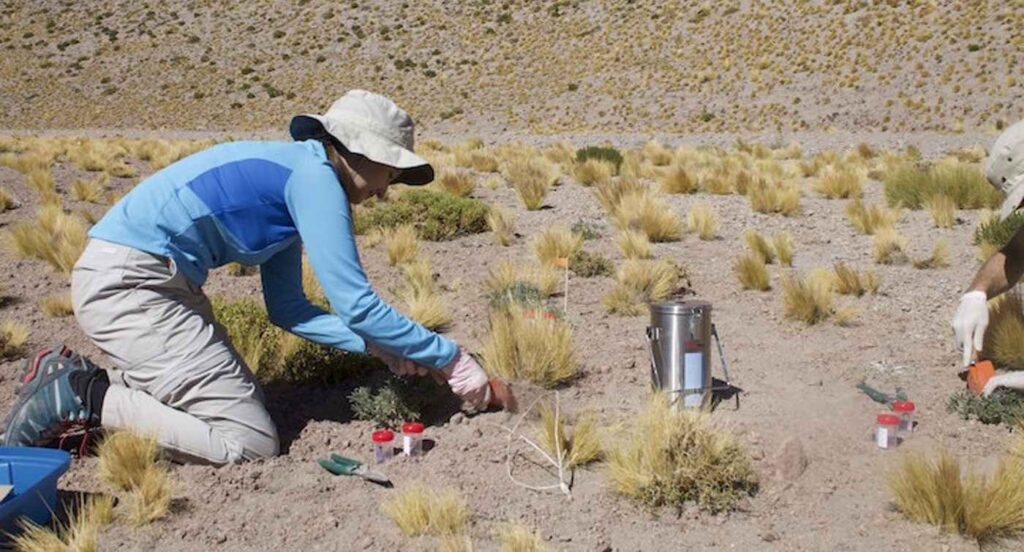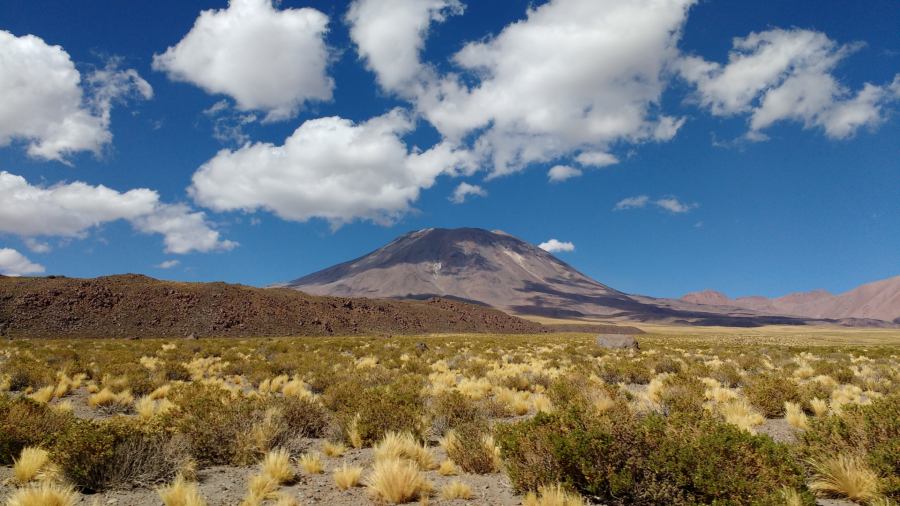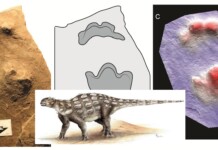
A “genetic goldmine” that could help crops survive global warming has been unearthed—in the driest desert in the world.
Plants growing in the Atacama Desert in northern Chile hold the key to coping with climate change, according to new research.
They have evolved genes that enable them to thrive in the most Mars-like region on Earth.
Most are closely related to staple foods such as grains, legumes, and potatoes.
It opens the door to engineering hardier fruit and vegetables, say scientists.
Lead author Professor Gloria Coruzzi, of New York University, said, “In an era of accelerated climate change, it’s critical to uncover the genetic basis to improve crop production and resilience under dry and nutrient-poor conditions.”
The coastal desert—sandwiched between the Pacific coast and the Andes mountains—is an arid plateau. Yet at springtime, a little corner is covered in a carpet of flowers. The purple pata de guanaco and yellow ananuca are among more than 200 species of plants that bloom.
They thrive in an inhospitable environment that averages just 0.01 centimeters of rainfall a year.
Other varieties include grasses, annuals, and perennial shrubs.
Mesquite trees, buckwheat bush, ferns ,and black sage have deep roots and fleshy leaves that retain the moisture.
The toughest plants on Earth

Now an international team is getting to the bottom of a phenomenon that has baffled scientists for decades.
They established an unparalleled “natural laboratory” that identified specific genes and microbes that power the toughest plants on the planet.
It is hoped the findings in Proceedings of the National Academy of Sciences will help feed the world in the coming decades.
Co-lead author Prof Rodrigo Gutierrez, of The Pontifical Catholic University of Chile, said, “Our study of plants in the Atacama Desert is directly relevant to regions around the world that are becoming increasingly arid, with factors such as drought, extreme temperatures, and salt in water and soil posing a significant threat to global food production.”
MORE: The Search Engine That Plants Trees With Every Search Has Just Planted its 100-Millionth Tree
The plants must also cope with high altitude, low availability of nutrients in the soil and extremely high radiation from sunlight.
Over a ten-year period the researchers collected, labelled, and froze the 32 most dominant plants.
They were taken from 22 sites across the desert in different vegetational areas and at every 100 metres of altitude.
The samples were kept in liquid nitrogen and sent 1,000 miles kept under dry ice to Prof Gutierrez’ lab in Santiago where staff mapped their DNA.
Some grew where temperatures fluctuated more than 50 degrees from day to night—or there was very high radiation.
Others were found in soil that was largely sand and lacked nutrients—with the only annual rain falling over a few days.
RELATED: Peru is Protecting Machu Picchu By Planting One Million Trees to Guard Against Mudslides and Fires
Analysis showed some species developed growth-promoting bacteria near their roots.
The adaptive strategy optimizes the intake of nitrogen—critical for growth—in the nutrient-poor soils of the Atacama.
Genes whose protein sequences were adapted were then identified by comparing the plants with 32 similar ‘sister’ species.
This was done through a technique called phylogenomics that reconstructs an organism’s family tree.
Prof Corruzi said, of the findings, published in Proceedings of the National Academy of Sciences, “The goal was to use this evolutionary tree based on genome sequences to identify the changes in amino acid sequences encoded in the genes that support the evolution of the Atacama plant adaptation to desert conditions.”
Some of the riverbeds in Atacama have been dry for about 120,000 years.
Daytime temperatures are around 25 degrees Celsius—dipping to minus two at night. NASA has investigated it for clues to potential life in the Martian sub-surface.
Co-author Dr Gil Eshel, of NYU, said, “This computationally intense genomic analysis involved comparing 1,686,950 protein sequences across more than 70 species.
“We used the resulting super-matrix of 8,599,764 amino acids for phylogenomic reconstruction of the evolutionary history of the Atacama species.”
LOOK: First Drone Project of Its Kind in Canada is Aiming to Plant 1 Billion Trees by 2028
The study identified 265 candidate genes whose protein sequence changes were selected by evolutionary forces.
These mutations could underlie plant adaptation to the desert conditions.
They include genes involved in response to light and photosynthesis, which may enable plants to adapt to the extreme radiation.
Similarly, the researchers uncovered genes involved in the regulation of stress response, salt, detoxification and metal.
They may be related to withstanding a nutrient-poor environment.
Most studies on plant tolerance have been based on lab experiments using a few model species – missing the ecological context.
Co-author Dr Viviana Araus, a member of Prof Gutierrez’ lab, said: “By studying an ecosystem in its natural environment, we were able to identify adaptive genes and molecular processes among species facing a common harsh environment.”
The surprising blossom in the Atacama is known locally as the “flowering desert.”
Prof Gutierrez said: “Most of the plant species we characterised in this research have not been studied before.
MORE: Scientists Use Recycled Sewage Water to Grow 500-Acre Forest in the Middle of Egyptian Desert
“As some Atacama plants are closely related to staple crops, including grains, legumes, and potatoes, the candidate genes we identified represent a genetic goldmine to engineer more resilient crops, a necessity given the increased desertification of our planet.”
The desert is also an astronomer’s paradise. With its crystal clear skies and bone dry air, some of the most powerful telescopes in the world are housed there.
PLANT a Little Good News in Those Social Feeds…



















